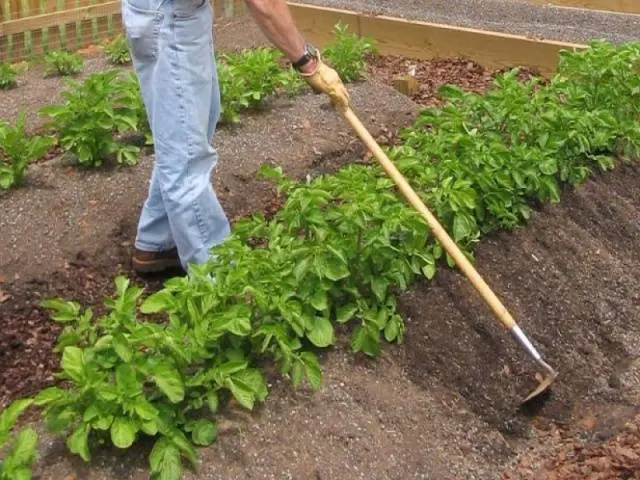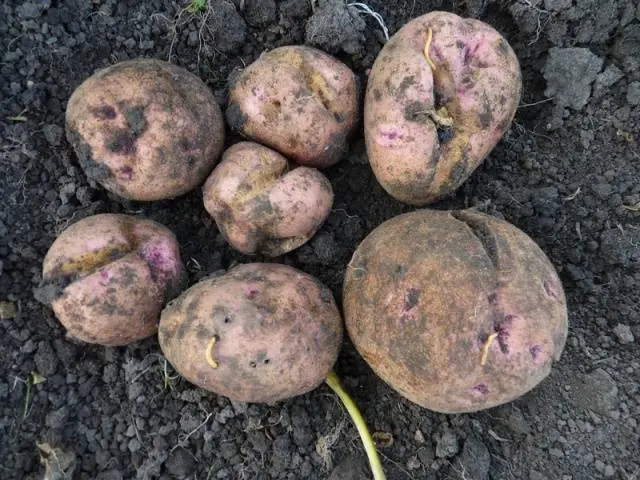Contents
There is no summer resident in Our Country who has not heard about the Sineglazka potato. This is an old variety, tested by time and thousands of gardeners, which has not lost its relevance for eighty years. Farmers love Sineglazka potatoes for the unsurpassed taste of tubers – no Dutch hybrids can compare with it. Anything can be cooked from the harvest of this potato, the culture rarely gets sick, it bears excellent fruit – just a summer resident’s dream! But Sineglazka also has its drawbacks, the most important of which experts consider poor keeping quality.

Photos, reviews and description of Sineglazka potatoes – all information is collected in this article. Below, all the pros and cons of the old domestic variety will be listed, it will be told how to properly grow these potatoes.
History of origin
The potato variety Sineglazka was bred back in 1940. The author of the new potato was a breeder from the Institute of Starch Products S. Demin. To get a hybrid of Sineglazka, the scientist crossed several varieties of cultivated potatoes with a wild variety.
The potato has passed many tests at the experimental stations of the country, and as a result it has been recognized as unpromising. However, such a decision of specialists did not prevent the country’s farmers from successfully growing Sineglazka on their plots for decades.
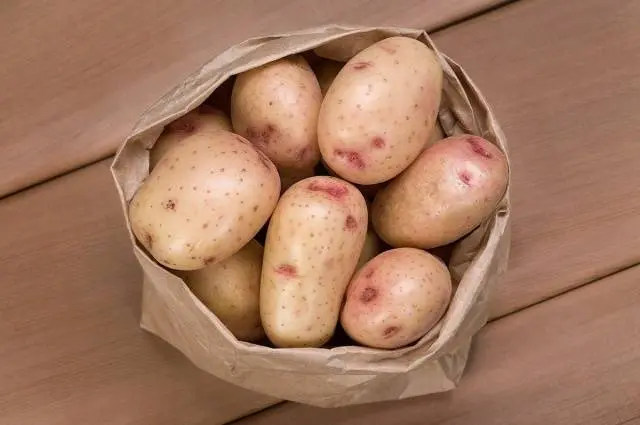
Varietal characteristics
The description of the Sineglazka potato variety should begin with its features: this potato has an average ripening time and a very extended growing season. You can harvest the first crop of young tubers at the end of June, and potatoes can be in the ground until September.
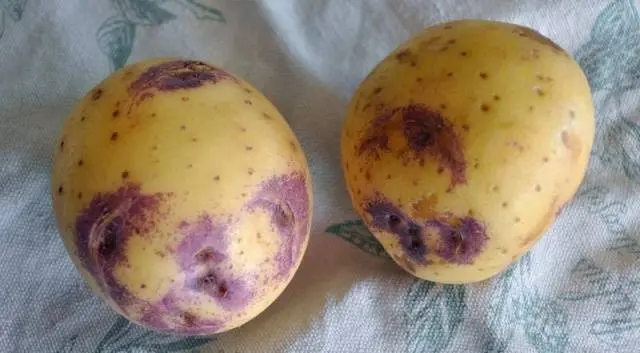
The characteristics of potatoes of the Sineglazka variety are as follows:
- the ripening period is from 85 to 100 days;
- potato bushes are powerful, rather tall, sprawling;
- shoots are thick, the root system is highly developed;
- the growth of green mass is plentiful;
- leaves of medium size, painted in dark green;
- the inflorescences of Sineglazka are small, light blue;
- berries with seeds on bushes are rarely formed;
- potato prefers light, sandy, nutritious soil; it bears fruit poorly on heavy and judgmental soils;
- the yield of the Sineglazka variety is high – about 500 centners per hectare;
- in each bush ripens from 8 to 12 tubers;
- potatoes are large, the average mass of tubers is 170 grams;
- the shape of the potato is oval, slightly flattened;
- tubers are painted in a pinkish-gray hue;
- shallow eyes, few of them, painted in a blue-lilac hue
- the pulp is white, dense;
- percentage of starch – 15%;
- Blue-eyed tubers are considered very nutritious, suitable for dietary nutrition;
- the taste of potatoes is high – fragrant and tender mashed potatoes are obtained from the Sineglazka variety, this potato is suitable for frying, stewing, preparing salads and any other dishes;
- potato variety Sineglazka shows resistance to common diseases of nightshade crops (potato cancer, late blight, nematode, scab);
- the peel on the tubers is quite thin, so they can be damaged by the wireworm – the larvae of the click beetle;
- Blue-eye quickly degenerates, losing its strong qualities, so farmers should not use their own material for planting for several years in a row;
- the harvest of Sineglazka is stored poorly, especially in large quantities – most of the tubers are affected by rot;
- for successful storage, potatoes must be put in small wooden boxes and placed in a spacious dry cellar;
- the yield of Sineglazka and the quality of tubers are highly dependent on weather conditions and soil composition.
Varietal qualities are fully preserved only in potatoes grown from seeds. In order to grow a high-quality Blue-eye that has retained its yield, taste and immunity to diseases, it is necessary to regularly update the planting material.

Advantages and disadvantages
Sineglazka would not have retained her popularity for such a long period of time if she did not have strong qualities. The reviews of summer residents and gardeners about this potato are the most positive – s love the Sineglazka variety and are in no hurry to change it to more modern hybrids.
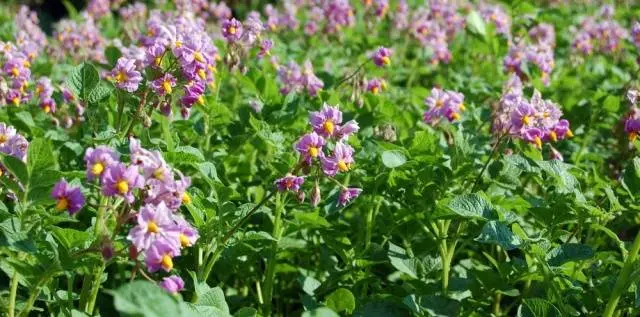
The advantages of the domestic variety of potatoes are as follows:
- excellent taste, pronounced potato taste and aroma;
- wide culinary possibilities (you can cook anything from Sineglazka);
- immunity to the most common infections of nightshade crops;
- large tubers of even shape and beautiful appearance;
- thin peel and superficially located few eyes;
- large growing area;
- high yield.
Among other advantages, people note the greater resistance of Sineglazka to the Colorado potato beetle compared to other popular potato varieties. However, this information has not been officially confirmed.
The Hannibal variety also has disadvantages, it is because of them that these potatoes are not planted on an industrial scale. Farmers note the following disadvantages:
- rapid and obvious degeneration of planting material;
- lack of quality seeds for sale;
- unsuitability of tubers for storage;
- the possibility of damage to potatoes by wireworms.
Because of these shortcomings, they are trying to replace Sineglazka potatoes with new, more modern counterparts. In recent years, several varieties of potatoes similar to Sineglazka have appeared. Dubravka potatoes are called the most popular and successful: the tubers are just as tasty and beautiful, and they also have excellent keeping quality.
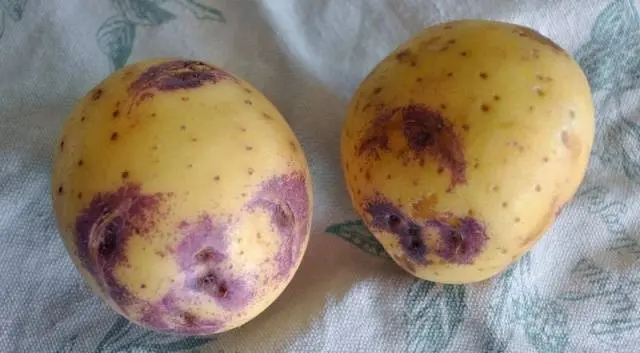
Many gardeners do not know how to choose the right Sineglazka potato for planting and how to propagate it – for this reason, negative reviews about the variety may appear. The fact is that very few fruits are formed in the Hannibal variety, and it is problematic to collect seeds from the bushes. Therefore, reproduction and renewal with their own seeds is almost impossible. The best option is to look for agricultural firms selling seed potatoes, which retain varietal characteristics.
Agrotechnics
If you grow potatoes from high-quality planting material obtained from seeds and not infected with viruses and bacteria, you can be sure of the result – Sineglazka will not let you down.
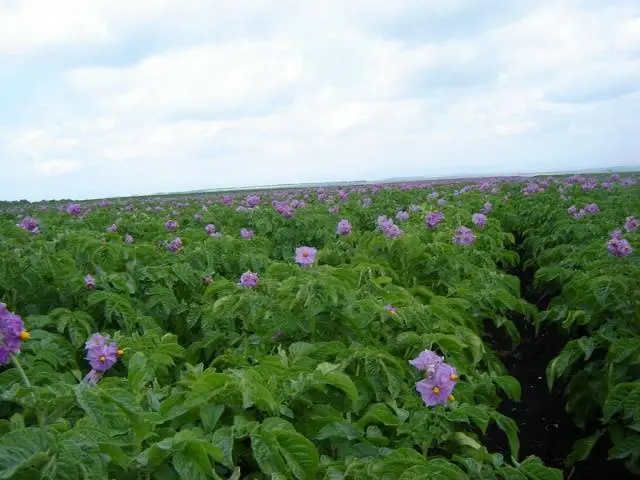
Of course, this potato, like the rest, prefers loose soils rich in fertilizers, it needs watering, weeding and processing. But, as practice shows, even in adverse weather conditions and with minimal agricultural technology, the varietal Sineglazka will give a good harvest.
Planting and care
It is necessary to plant Hannibal tubers in the second half of April or early May. The exact planting time is calculated so that the sprouted bushes do not freeze during the May frosts (the timing is individual for each region).
It is not difficult to take care of potato bushes, but this must be done – a lack of attention will greatly affect the quantity and quality of the crop. The rules for caring for Sineglazka are simple:
- Watering this potato needs moderate watering – during the season the earth is moistened no more than five times. Often, natural rainfall is sufficient for normal growth of potatoes.
- The soil must be loosened, and sprawling bushes must be spudded. To protect the tubers from overheating and the soil from drying out, it is recommended to use mulch.

- Top dressing for Sineglazka is very important. These large potatoes prefer root feeding with organic fertilizers such as slurry or bird droppings diluted in water. Mineral fertilizers in the form of ammonium nitrate, superphosphate or ammonium sulfate are also effective. Do not be zealous with nitrogen, it will only increase the green mass.
- Potatoes grown from seeds will remain disease resistant for the first couple of years. Subsequently, chemical treatments cannot be avoided, and it is recommended to treat not only bushes, but also tubers and soil before planting. To protect potatoes from wireworm, which can harm the presentation of tubers, plants should be sprayed with insecticides against the click beetle.

- The best taste qualities are noted in the blue-eye at the end of August. It is during this period that it is recommended to harvest this potato. Immediately after digging, the tubers must be dried in the fresh air, so they are left in the open air for 3-5 hours. If the weather is rainy, the crop is laid out to dry under a canopy.
Write Your Review
Conclusion
Sineglazka has a lot of advantages, this potato is tasty, has a spectacular appearance (which is confirmed by the photo), pleases with large crops. Gardeners of the country agree to put up with the shortcomings of the variety and are looking for ways to deal with them: they grow seedlings of potatoes from their own seeds, ventilate storage facilities, sort out the crop.
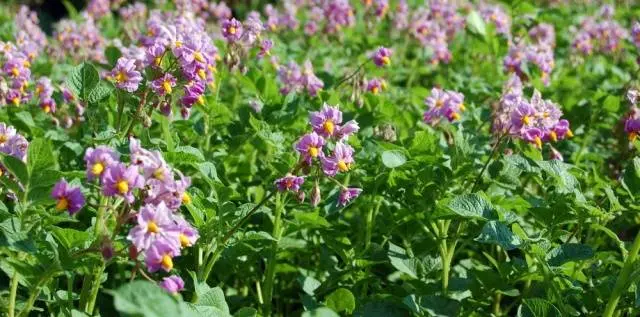
Despite the fact that new hybrids and analogues appear every year, blue-eye remains one of the most favorite varieties among summer residents and gardeners in the country.










